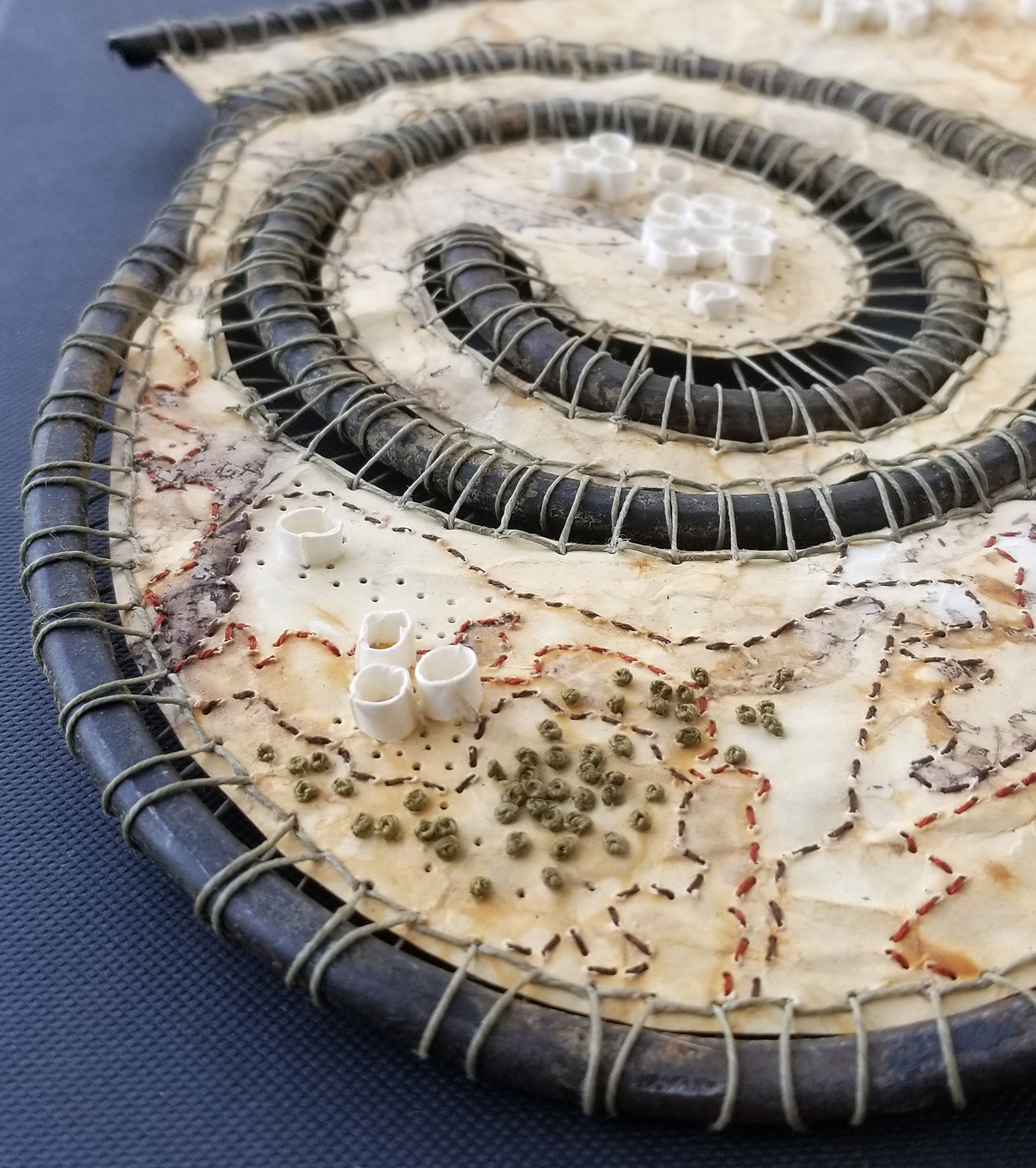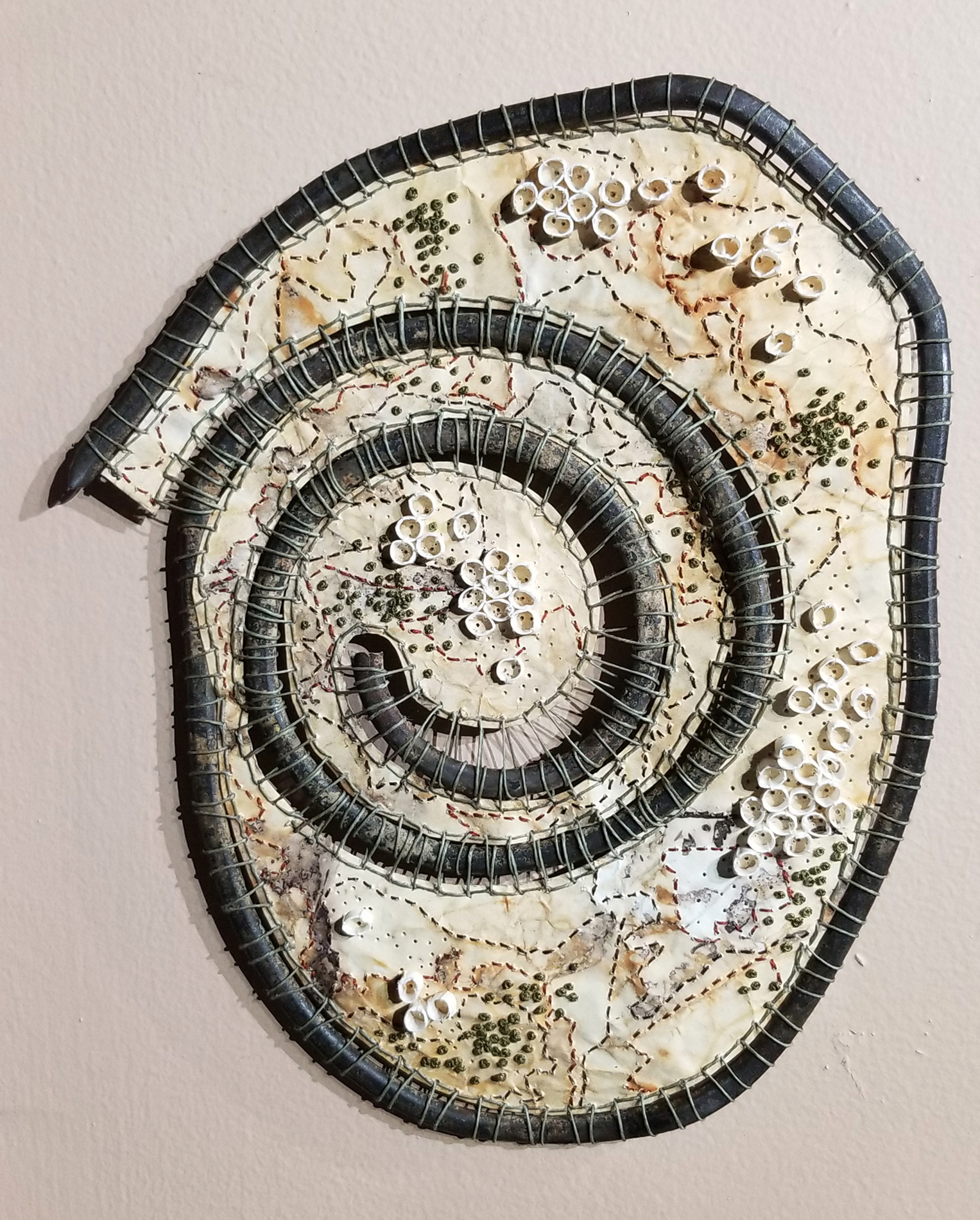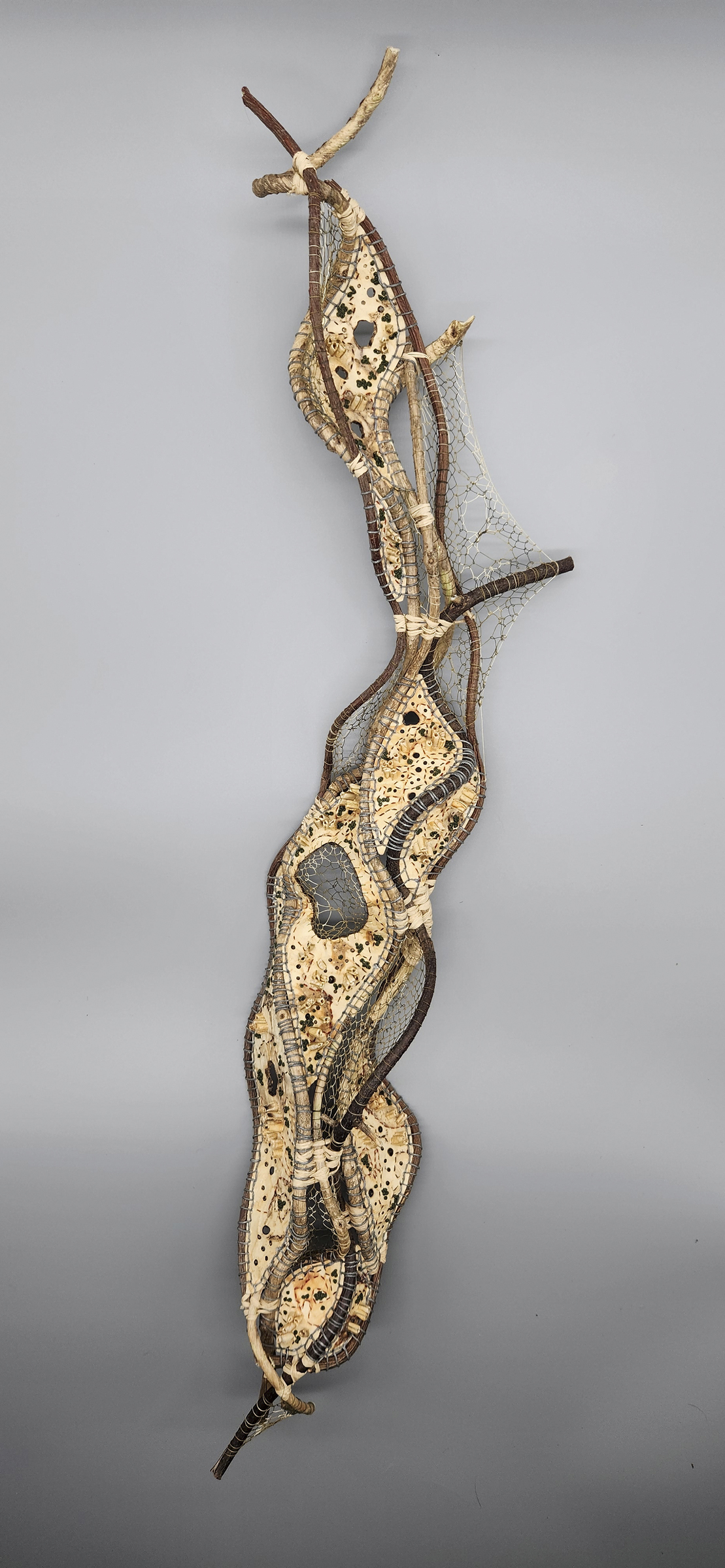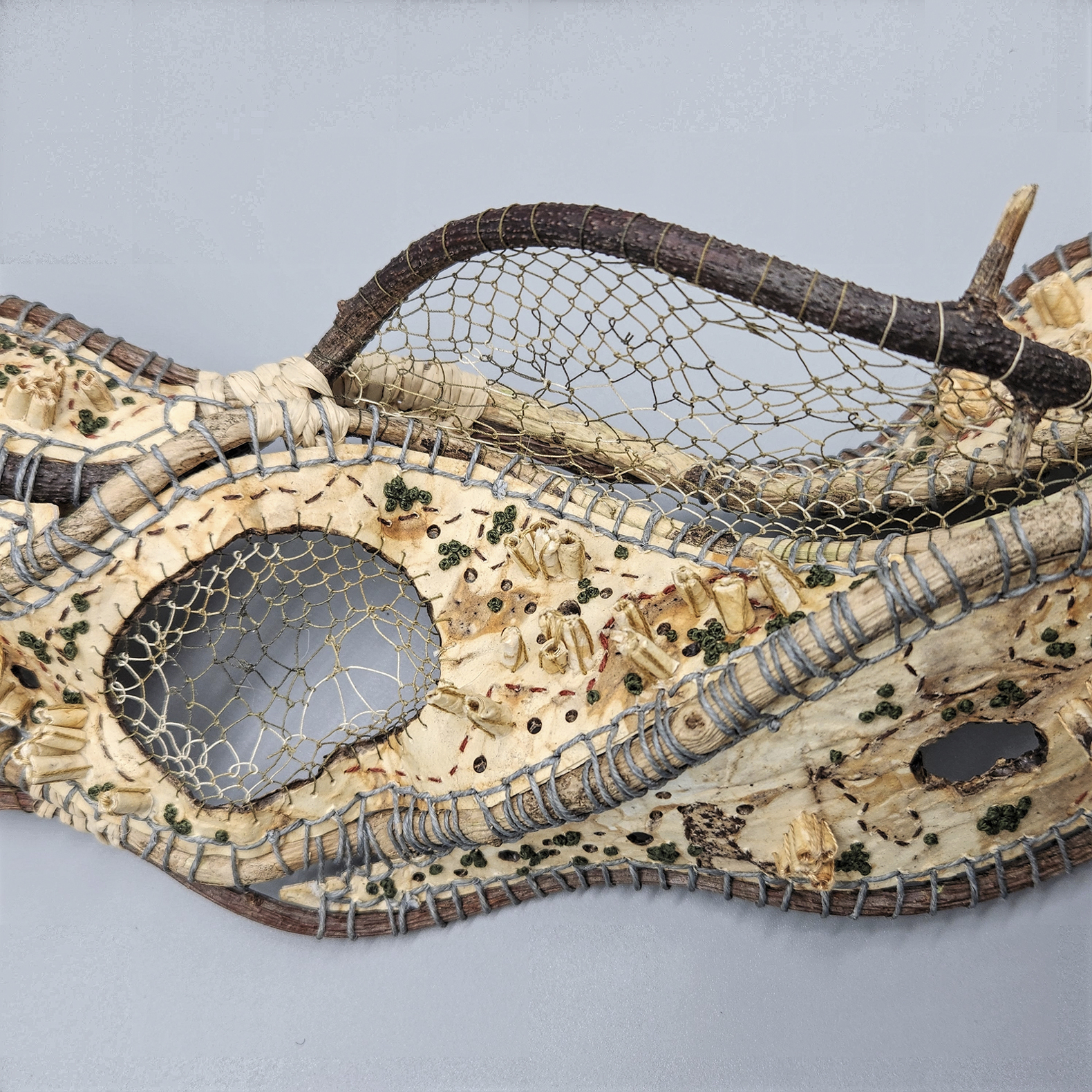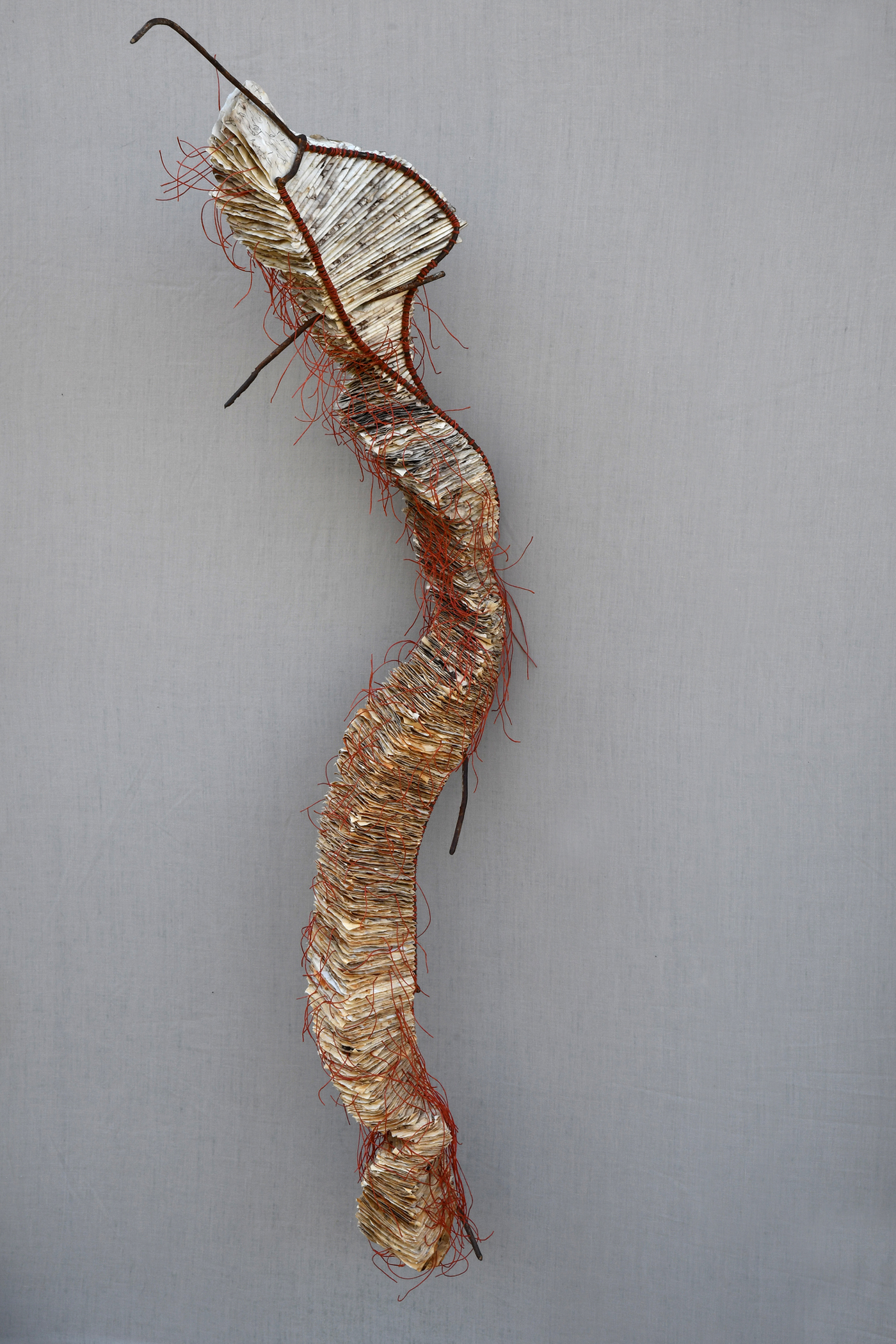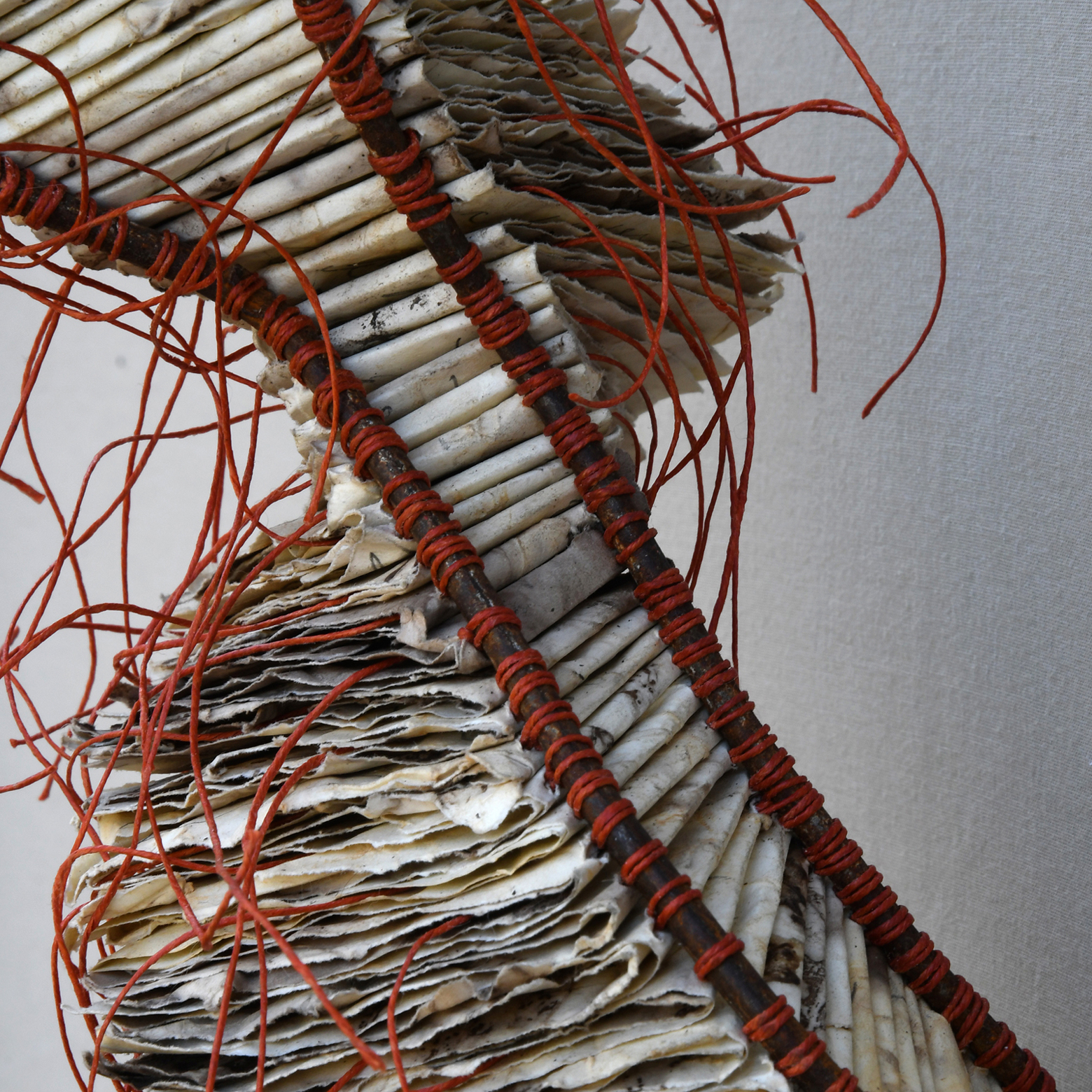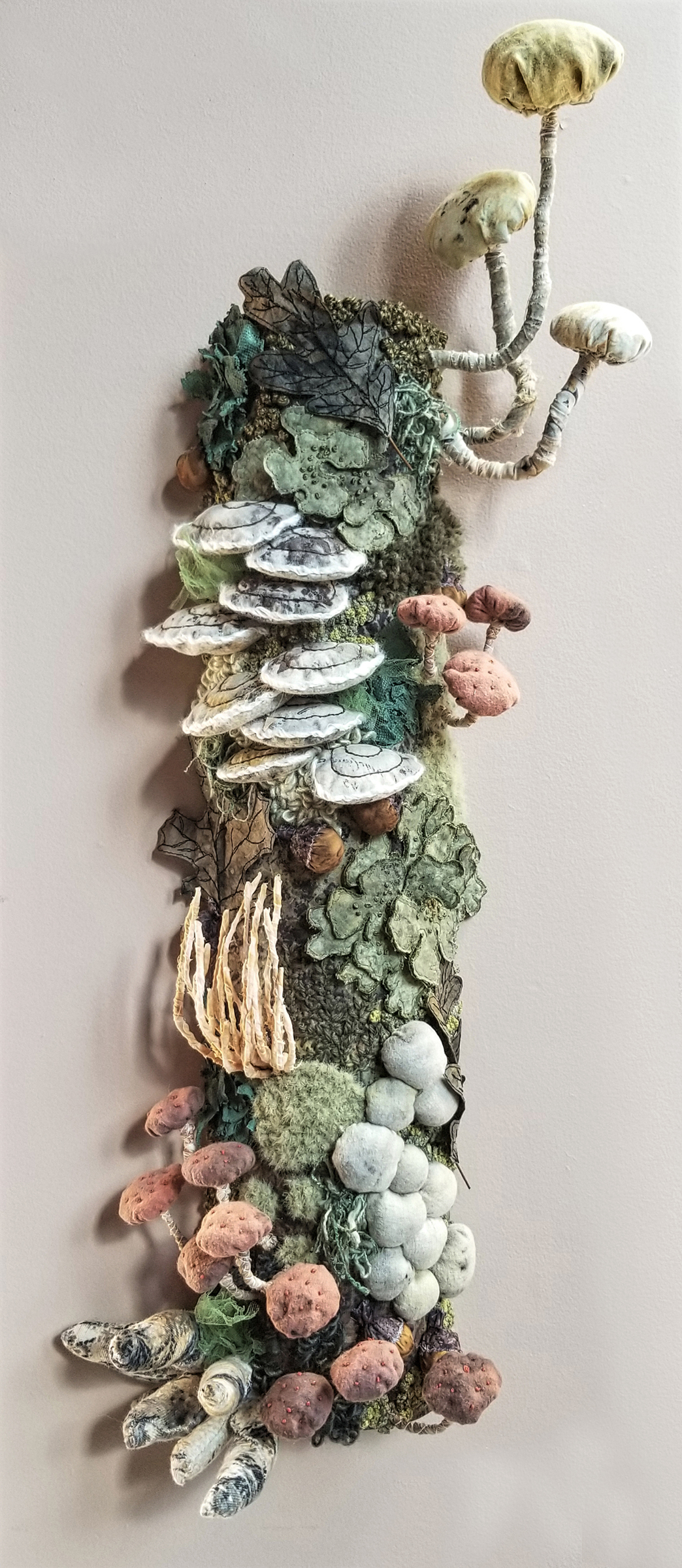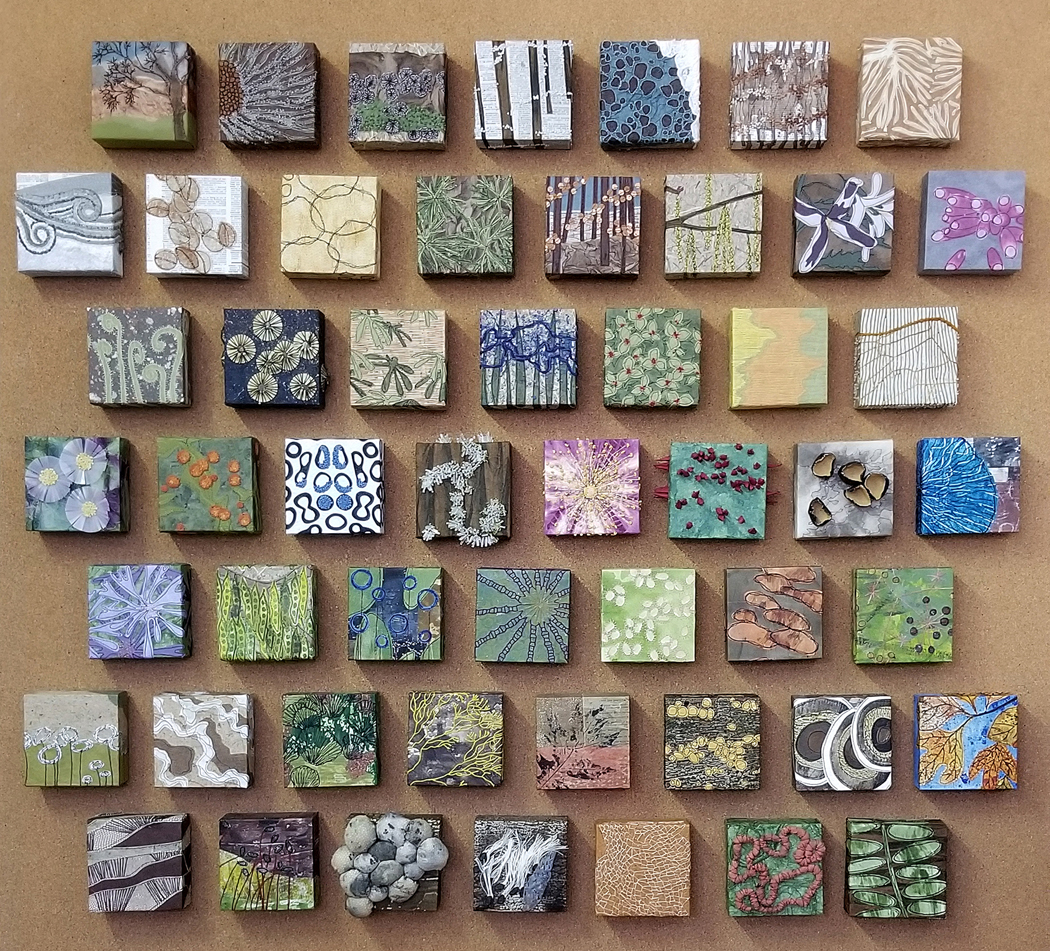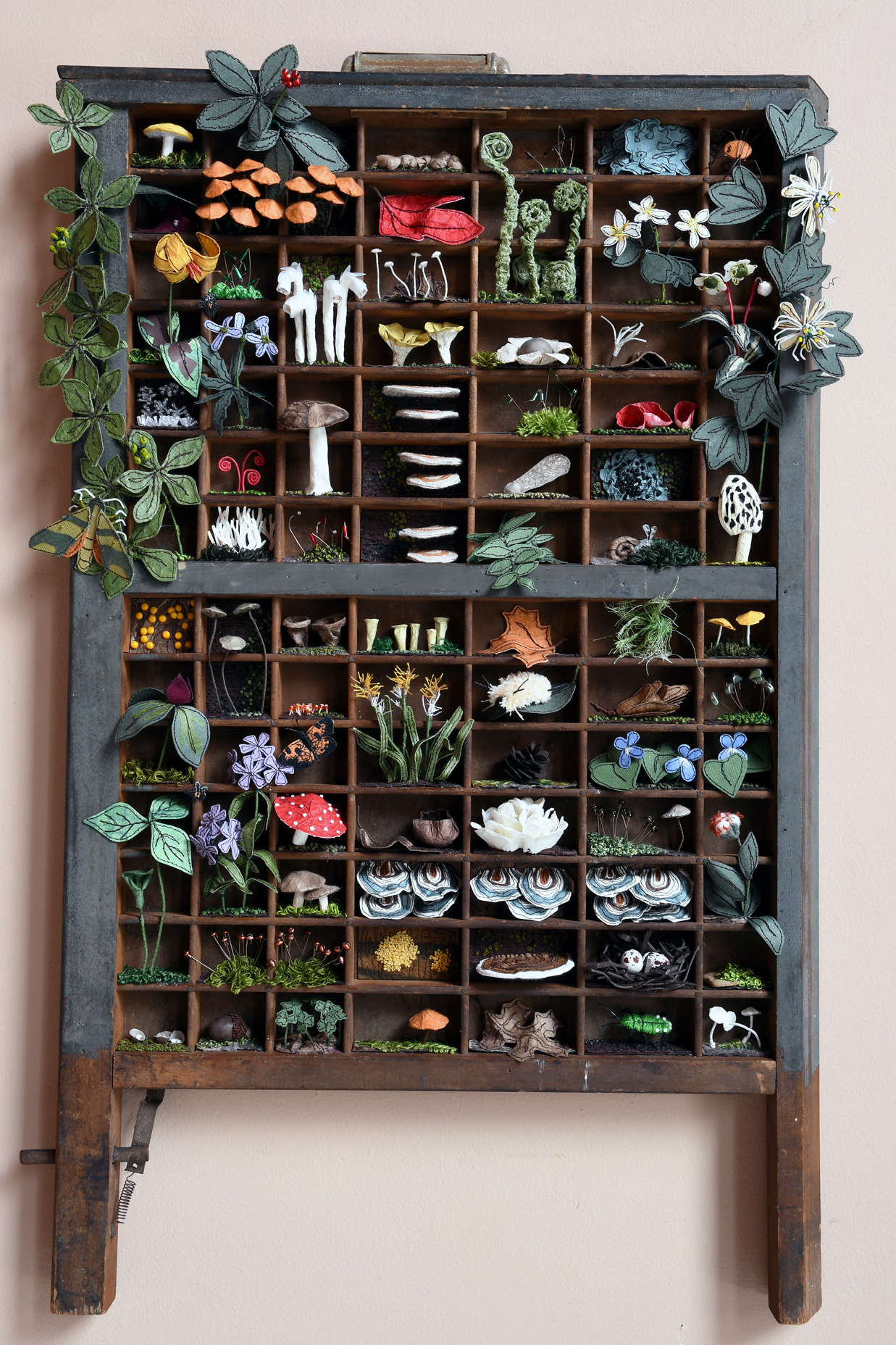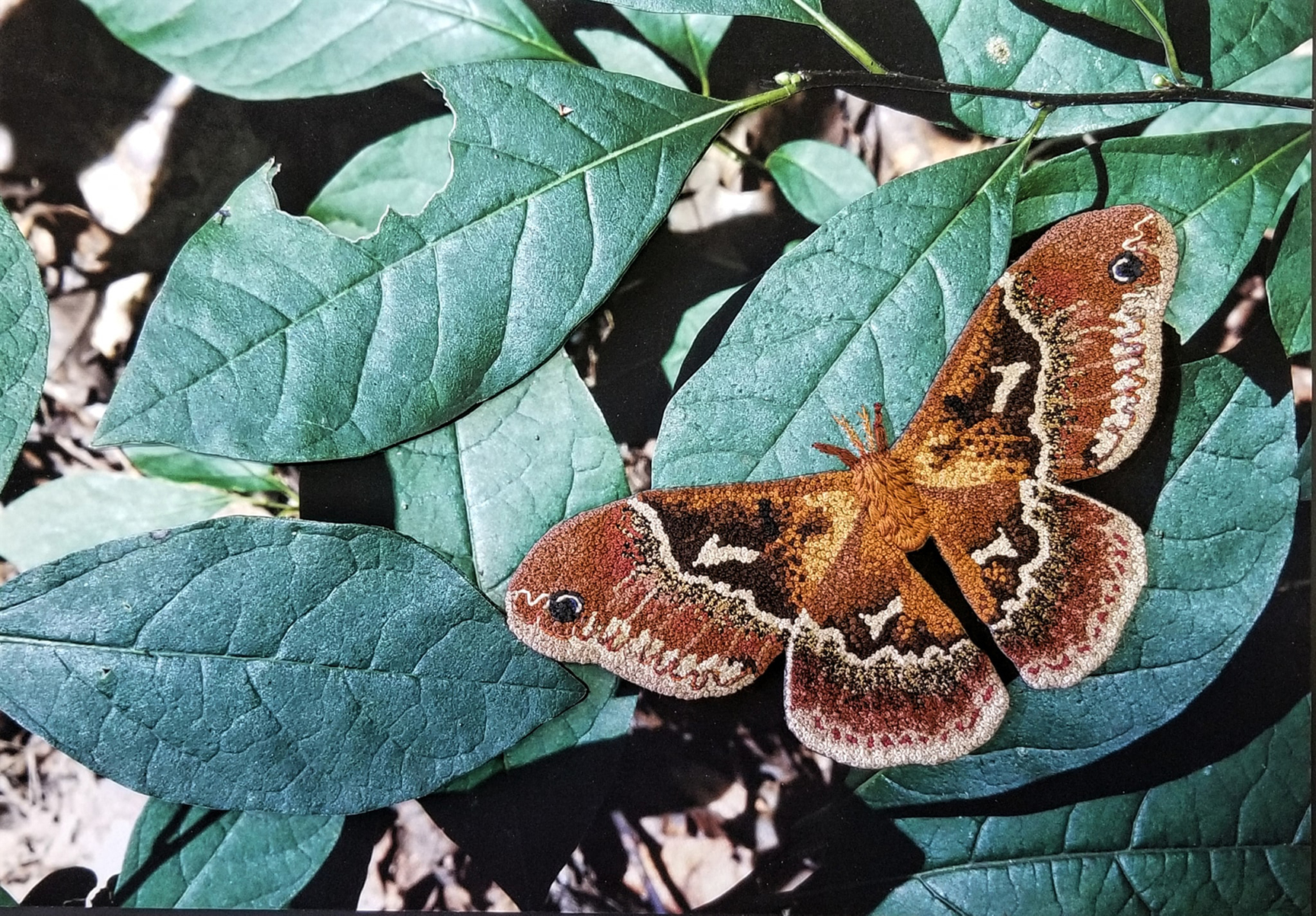Michele Pollock
Map to an Unknown Location (detail), 2022
Found metal, eco-dyed leftover papers, waxed linen, cotton embroidery thread, paper straws 11" x 9"
While dealing with a Sclerodema diagnosis, which made my old ways of making impossible, I've been hand quilting, burning & embroidering paper that I eco-dye with local leaves. The intuitive quilts are fragile skins, maps to unknown places, the shapes of cells under the microscope. I combine these small quilts with metal objects rescued from the scrapyard, which are bent, broken, rusted and no longer able to perform their original uses.
Michele Pollock
Map to an Unknown Location, 2022
Found metal, eco-dyed leftover papers, waxed linen, cotton embroidery thread, paper straws 11" x 9"
While dealing with a Sclerodema diagnosis, which made my old ways of making impossible, I've been hand quilting, burning & embroidering paper that I eco-dye with local leaves. The intuitive quilts are fragile skins, maps to unknown places, the shapes of cells under the microscope. I combine these small quilts with metal objects rescued from the scrapyard, which are bent, broken, rusted and no longer able to perform their original uses.
Michele Pollock
How Grief Moves Through the Heart, 2022
Foraged invasive Bittersweet vines; raffia; paper left over from bookbinding work I can no longer do because of chronic illness; interfacing; cotton embroidery thread; cotton sewing thread; waxed linen thread 26" x 8" x 4"
Over the past year or so, while coming to terms with being diagnosed with Scleroderma (a rare autoimmune disease that makes it difficult to do many things, including machine stitching), I started hand quilting, burning, and hand embroidering into paper that I eco-dyed using leaves from my forest floor. The small intuitive quilts are like fragile skins, like maps to unknown places, like the shapes of cells and antibodies under the microscope. I foraged invasive Bittersweet vines from my woods, where they wrap around small trees and branches and can be harvested with amazing spiral shapes. When I laid out the vines on my workbench and twined them with raffia where they touched, it created a solid structure with curved shapes and spaces between the vines. I've been searching for ways to "frame" or present my little quilts, and I cut pieces to fit in some of the spaces between the vines and attached them to the vines using waxed linen thread and a modified bookbinding stitch. In the remaining spaces, I wanted something more open, less solid, to contrast with the quilts. I looped in those spaces using fine cotton variegated sewing thread that I waxed with beeswax. These "webs" are delicate and messy, yet dimensionally stable. They have holes and ragged spots yet remain structurally sound and have their own strange beauty, like old cobwebs in nature but also like my tangled emotions, my struggle to come to terms with my illness and remain intact.
Michele Pollock
How Grief Moves Through the Heart (detail), 2022
Foraged invasive Bittersweet vines; raffia; paper left over from bookbinding work I can no longer do because of chronic illness; interfacing; cotton embroidery thread; cotton sewing thread; waxed linen thread 26" x 8" x 4"
Over the past year or so, while coming to terms with being diagnosed with Scleroderma (a rare autoimmune disease that makes it difficult to do many things, including machine stitching), I started hand quilting, burning, and hand embroidering into paper that I eco-dyed using leaves from my forest floor. The small intuitive quilts are like fragile skins, like maps to unknown places, like the shapes of cells and antibodies under the microscope. I foraged invasive Bittersweet vines from my woods, where they wrap around small trees and branches and can be harvested with amazing spiral shapes. When I laid out the vines on my workbench and twined them with raffia where they touched, it created a solid structure with curved shapes and spaces between the vines. I've been searching for ways to "frame" or present my little quilts, and I cut pieces to fit in some of the spaces between the vines and attached them to the vines using waxed linen thread and a modified bookbinding stitch. In the remaining spaces, I wanted something more open, less solid, to contrast with the quilts. I looped in those spaces using fine cotton variegated sewing thread that I waxed with beeswax. These "webs" are delicate and messy, yet dimensionally stable. They have holes and ragged spots yet remain structurally sound and have their own strange beauty, like old cobwebs in nature but also like my tangled emotions, my struggle to come to terms with my illness and remain intact.
Michele Pollock
Catharsis, 2023
Found metal, eco-dyed leftover papers, waxed linen, pencil 40" x 14" x 12"
When I found this piece of rusted metal on one of our field trips to the scrapyard, bent and deformed and no longer useful for its original purpose, it reminded me of grief, of anger, of loss, of anxiety – and I thought I might find a way to affix my own emotions to its structure, to use it as an armature for my own volatile feelings about having Scleroderma and the limitations it places on my body and my life. I can no longer handle bookbinding like I used to do it, making blank book after blank book, but I can bind one or two signatures of a book per day. I no longer have use for the reams and reams of white text-weight paper left over from making blank books, but I can repurpose that paper by eco-dying it using leaves from my woods. After dying it, I tore the paper to size and folded it into signatures of 8 small pages each. Then, almost daily, I did automatic writing on one of these small signatures, purging myself of negative emotions, my hand moving as fast as my mind was going, so the final writing is – thankfully – illegible. Handwriting bears witness to the body, uses the body, demands of the body, taxes the body. The point is not to ever go back and read this journal, or to let anyone else read it, but to rid myself of the emotions, to channel them into another vessel. I bound each of the signatures individually to the rusted and bent metal piece using waxed linen thread and a modified Coptic binding stitch. Returning to the piece almost daily for nearly a year, the piece grew slowly, slowly – literally converting grief and anxiety and loss into artwork, signature by signature, joining my difficult emotions to strange beauty – or if not beauty, exactly, then a kind of grace and movement. What does it mean to work on something for an extended period of time? Time itself becomes a raw material in the work. The time spent making this piece is the whole point, really. The catharsis is in the writing itself, in the making, in the alchemy of converting emotions into something material, something apart from myself that I can examine and observe. The making IS the artwork, and the final piece is really an artifact of that time spent making.
Michele Pollock
Catharsis (detail), 2023
Found metal, eco-dyed leftover papers, waxed linen, pencil; 40" x 14" x 12
When I found this piece of rusted metal on one of our field trips to the scrapyard, bent and deformed and no longer useful for its original purpose, it reminded me of grief, of anger, of loss, of anxiety – and I thought I might find a way to affix my own emotions to its structure, to use it as an armature for my own volatile feelings about having Scleroderma and the limitations it places on my body and my life. I can no longer handle bookbinding like I used to do it, making blank book after blank book, but I can bind one or two signatures of a book per day. I no longer have use for the reams and reams of white text-weight paper left over from making blank books, but I can repurpose that paper by eco-dying it using leaves from my woods. After dying it, I tore the paper to size and folded it into signatures of 8 small pages each. Then, almost daily, I did automatic writing on one of these small signatures, purging myself of negative emotions, my hand moving as fast as my mind was going, so the final writing is – thankfully – illegible. Handwriting bears witness to the body, uses the body, demands of the body, taxes the body. The point is not to ever go back and read this journal, or to let anyone else read it, but to rid myself of the emotions, to channel them into another vessel. I bound each of the signatures individually to the rusted and bent metal piece using waxed linen thread and a modified Coptic binding stitch. Returning to the piece almost daily for nearly a year, the piece grew slowly, slowly – literally converting grief and anxiety and loss into artwork, signature by signature, joining my difficult emotions to strange beauty – or if not beauty, exactly, then a kind of grace and movement. What does it mean to work on something for an extended period of time? Time itself becomes a raw material in the work. The time spent making this piece is the whole point, really. The catharsis is in the writing itself, in the making, in the alchemy of converting emotions into something material, something apart from myself that I can examine and observe. The making IS the artwork, and the final piece is really an artifact of that time spent making.
Michele Pollock
Against Forgetting What Has Been Lost, 2021
Eco-dyed recycled cotton fabric, yarn, hardware cloth, wire, cotton embroidery thread, interfacing, acrylic paint 24" x 8"
I've developed a rare autoimmune disease which has made it very difficult for me to hike in my woods any longer, and this piece was created as a way for me to memorialize, for myself, the experience of being in the forest. The recycled fabrics were eco-dyed with fallen leaves from the forest floor, and each element is based on something that I have actually observed, and photographed, in the woods. It is a souvenir of my life before Scleroderma, a reminder to myself that what has been lost to me is still alive in the world, and a love song to the forest floor.
Michele Pollock
The Tuesday Project, 2020-2021
Paper, acrylics, watercolors, cotton thread, beads, eco-dyed fabric, wire, image transfer, wood blocks 46" x 40"
On my 49th birthday, which was Tuesday, December 29 in 2020, I decided to create one piece of artwork each week until my 50th birthday, as a sort of celebration for myself. I chose 4" x 4" wood panels, for consistency, and because the small format increased the chances that I would have time to complete one piece per week. Otherwise, I had no idea what would emerge. I am a dedicated woods-walker, photographing the small treasures I find in the forest, and using those photographs as inspiration for my artwork. Therefore, I would base each work on something I saw and photographed in the woods or my garden during that week, and I would take notes on both what I saw and what I created. I called it "The Tuesday Project" when describing it to people, since I started it on a Tuesday. I didn't miss a week (though sometimes I didn't get the piece done on Tuesday). The final 52 pieces are presented here in the order in which I made them, and you can see when it was generally snowy, and when it greened up in Spring, and when it turned back toward oranges and browns in the Fall. You can see my obsession with mushrooms and wildflowers, trees and moths, slime molds and moss. This period was filled with the strangeness of Covid-19 and all its subsequent closures and delays. I was also suffering from, and trying to get diagnosed with, what I now know is the rare autoimmune disease Scleroderma. These two things meant that my schedule was more free than normal (no art fairs or other events) and my studio time was both limited and changing (the symptoms of Scleroderma limit my ability to machine sew, for instance). Because of Covid-19, many in-person workshops and classes went online, and that meant I had access to fiber art workshops with teachers around the world. You can see in these pieces that new techniques and materials are being absorbed into my practice as the year progresses. I pushed myself to try new things (abstraction and beading and gelli plate printed papers, for example) and gave myself permission to explore. Most of the pieces are made from some type of paper and include either machine or hand stitching, but there is also eco-dyed fabric and beads and paperclay and paint. Each piece was created flat as an 8” x 8” square, and then wrapped around the wood panel using archival PVA glue and bookbinding techniques. As the year progressed, I noticed connections forming between pieces. Shapes repeat themselves, both in nature and in my work, colors and patterns reappear, and favorite stitches (French knots!) emerge. The Tuesday Project was both fun and rewarding, and daily or weekly practice will now be a new and hopefully permanent part of my artistic journey.
Michele Pollock
Forest Sampler, 2020
Paper, cotton thread, beads, wire, paper clay, embroidery thread 15" x 28"
"Forest Sampler" is a three dimensional sampler (think of the samplers embroiderers make) featuring things I've seen over the last few years in my woods in Brown County, Indiana. Made with machine quilted paper, hand embroidery, beading, and paper sculpture. Displayed in an antique printer's tray. It was an adventure trying to engineer a way to re-create each forest finding in three-dimensions in paper. There are common things, like acorns and oak leaves and Virginia Creeper. But there is also the single Ginseng plant I found in my woods, and Fairy Sparkler fungus, and parasitic Ghost Plant. And of course Turkey Tail mushrooms, lots of moss, a couple slime molds and a moth.
Michele Pollock
Promethea Moth, 2021
Original inkjet photograph, fine art paper, cotton thread 19" x 23"
Hand-embroidered original photograph, featuring French knots, satin stitch and couching
